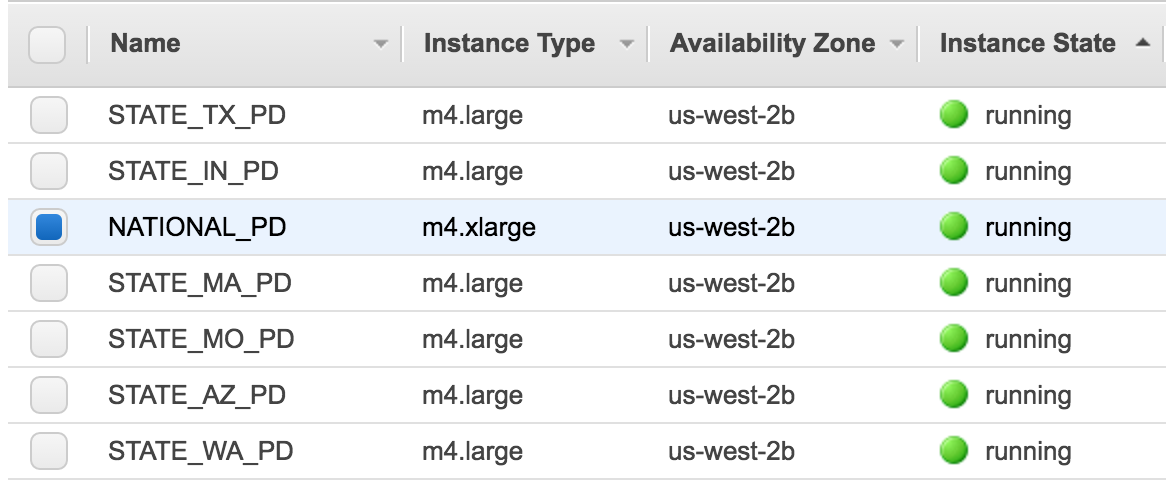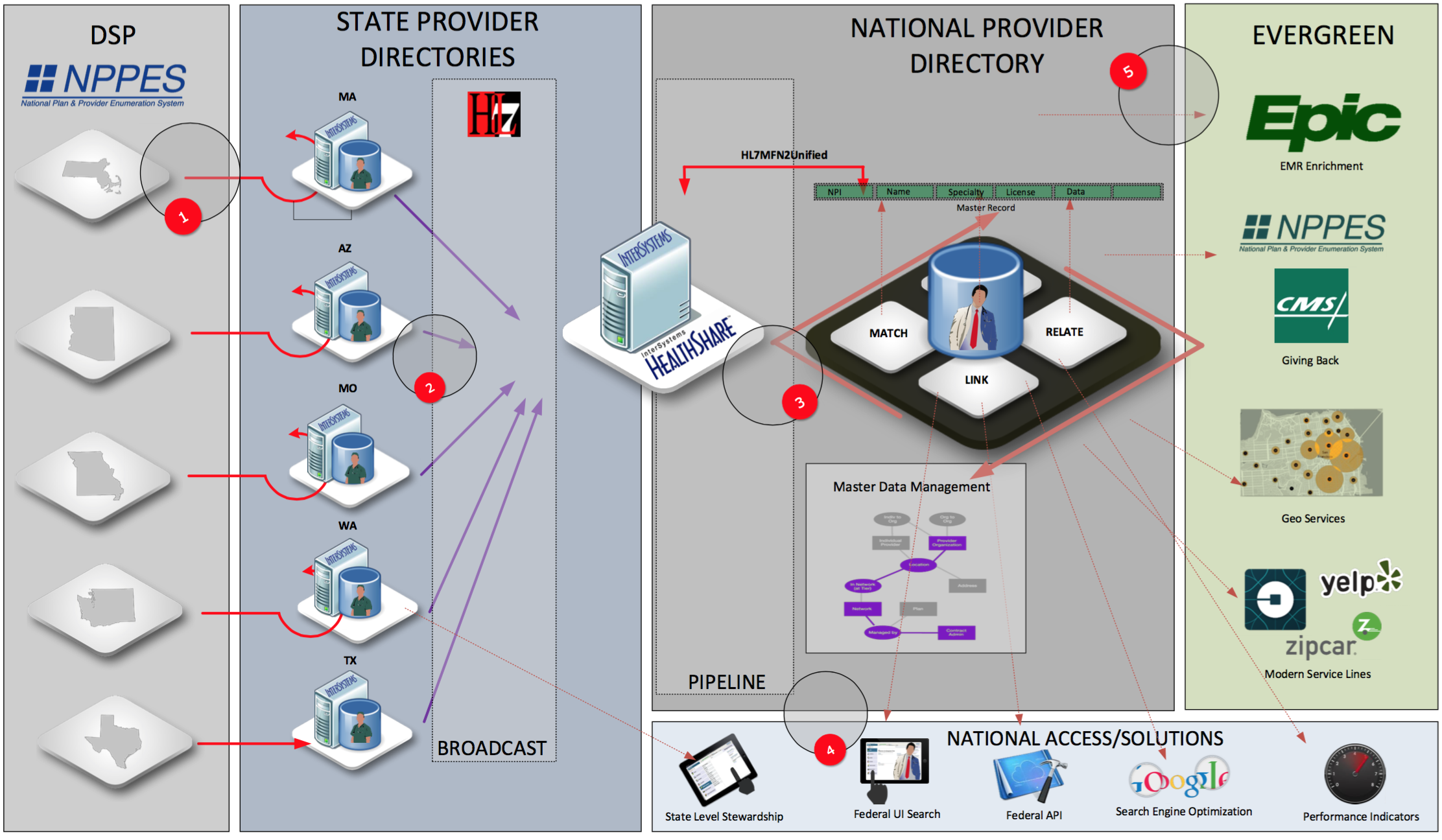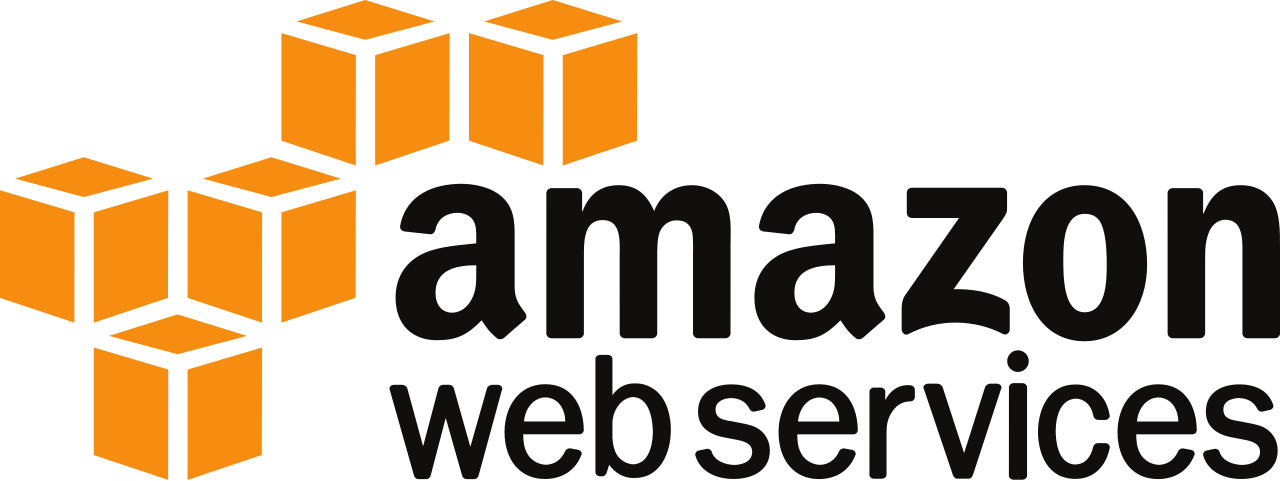 For Global Summit 2016, I set out to showcase a Reference Architecture I had been working on for a National Provider Directory solution with State Level Instances and a National Instance all running HealthShare Provider Directory and all running on AWS Infrastructure.
For Global Summit 2016, I set out to showcase a Reference Architecture I had been working on for a National Provider Directory solution with State Level Instances and a National Instance all running HealthShare Provider Directory and all running on AWS Infrastructure.
In short, I wanted to highlight:
- The implementation of Amazon Web Services to provision the infrastructure, including the auto-creation of the state level instances through Cloud Formation.
- The use of the HSPD Broadcast functionality to Notify Upstream Systems Changes in Master Provider Data.
- The implementation of a transformation of the standard Broadcast Object to HL7 MFN for interoperability.
- The principals of Master Data Management applied to the Provider Directory.
What we ended up with, was 52 state level instances of HSPD, mastering NPPES data at the state level, and forwarding those updates to a National Provider Directory via HL7 MFN/HSPD Broadcast.
 THE REFERENCE ARCHITECTURE
THE REFERENCE ARCHITECTURE
The pipe dream behind the architecture is an implementation of participating (mandantory) State Level Provider Directories powered with data that is aggregated, cleansed, related, codified and mastered using Master Data Management principals from contributing sources at the state level. These directories when under state level stewardship, emit events on update and creation of new records within their state demarcation, and fire off notification and forward the provider Information to a National Provider Directory instance for use cases to power the coordination of care in years to come. The solution must be scalable, secure, and congruent at the platform level for federal compliance to management and stewardship of the Provider Directory Domain.
In the diagram below, the Reference Architecture composes the solution with the following flow:
- Each state level will implement ingestion schedules of public data sets, such as NPPES and PECOS. The National Plan and Provider Enumeration System (CMS) is the top level assiging authority for Provider Individuals and Provider Organziations in the Country, which provides a head start for Providers with a top level identifier.
- The State Level Instances of the Provider Directories iterate over the ingestion of data sets they say fit to include in State level provider directory initiatives and the stewardship guidelines of the Master Data Management program. Upon event, these state-level instances forward broadcast messages to a single federal target provider directory for mastering at the national level. For purposes of demonstration, the Broadcast object of choice to forward to the National Provider Directory was HL7 Master File Notification, which was achieved through a transform deployed on the State Level Provider Directories.
- The National Provider Directory will then ingest, codify , re-relate, and master the provider Individuals and Organizations in the country for federal representation (of particular interest here would be the Organizations/Networks).
- Access to the Data can be achieved at the State and Federal level, though web/mobile applications, API's, extracts and the like. Data can be used as starting blocks for performance based indicators and be highly optimized for Search (SEO) to raise the attention level to the data for the consumers and also the prodiver represented.
- The proliferation of the data can be achieved through "Evergreening" source data, paying forward the broadcast to subscribers, or even modern service lines such as Uber, Zipcar, and Yelp.

So the above is the broad stroke at the solution without mention of the platforms that enable it. The following sections will outline two platforms that enable little 'ol me to go "Full Stack Architecture" from compute to healthcare interoperability without ever leaving their respective technologies, Amazon Web Services and InterSystems HealthShare.
 THE INFRASTRUCTURE
THE INFRASTRUCTURE
I meant to go really nuts with this, but blew the budget on Hotel for Global Summit and dialed back the footprint a bit on AWS to accomplish the demonstration of the Reference Architecture for the National Provider Directory. I will be refactoring this solution for AWS re:Invent in November, and will pull out the stops during the event to fully load NPPES thorugh the solution and full AWS representation of all states so stayed tuned.
I ended up the 6 State Level Directories that auto-provisioned through launch and configured themselves via a STATE switch on launch to talk to a static Instance I provisioned on EC2 as the National Provider Registry and a demo domain through Route53.
The state level instances used an instance type of M4.large, while the national one used an m4.xlarge all with mounts of SSD backed EBS volumes of 250GB. The underying OS was RHEL6, with optimizations for Cache that included gmheap, locksize, and kernel tuning to assgin more ram to the startup options of Cache.

These technical capabilities of the AWS ecosystem were easily available at launch of the product in 2006, but still allowed me to build the entire solution with little ol me and also allowed me to use hardware not available in the local Microcenter here in Cambridge.
 HEALTHSHARE PROVIDER DIRECTORY
HEALTHSHARE PROVIDER DIRECTORY
InterSystems has completely revamped the Provider Directory product (HSPD) for HealthShare with Master Data Management principals at its core, and utilizing a lot of the technology at play in their MPRL product for Patient Index to match and link not only Providers, but Orgs, Networks, Plans and other vital nouns in the business of delivery healthcare. The product has the ability to ingest data in a myriad of ways, which is in the blood of the product since inception, but also provide the ability to cleanse, govern, relate, master and curate that data through a stewardship task workflow.
In our solution, each State HSPD Instance is configured for Broadcast, with a personal integration to convert the broadcast object to HL7 MFN and forward to a business operation targetted at the national provider Directory. Each State is accountable for processing the entire NPPES file, with a Service restriction on the new NPPES Business Service for the state of the Practicing Address of the provider in context, either Individual or Organization. When the file gets ingested into the HSPD Pipeline, it is sent to the HSPD.MDM.Operation for consideration of consolidation by HSPD. If the consolidation of the results in the successful creation of a new Provider, Address, or other entity, a BroadCast message is generated frm the HSPD.Broadcast.Service. The Broadcast Service sends the metadata of what was updated to the HSPD.Broadcast.HL7.Process which transforms the data into an HL7 message and forwards it to the National PD for similar ingestion at that level. For those of you who know what I am talking about at this point, below is the screenshot of the production and an accompanying trace.
State Level HSPD Production

Trace

 PROVIDERS - MASTERED, RELATED
PROVIDERS - MASTERED, RELATED
An accurate, complete, and up to date Provider Directory has been a wish list for Health Systems for quite some time, and is a common practice amongst those trying to innovate to build their own provider repository to enable their value add to the innovation. However, a table with a bunch of Providers or Organization is merely the setup for the next quesiton of how the entities are related, which is the real party trick, and can be accomplished through Master Data Management practices. This is the first inclination that the Healthcare data model at play provided by the Reference Information Model by HL7 has developed some shortcomings for the changing healthcare landscape. The HL7 model put the patient in the center of everything, and all other things such as organizations, providers, and plans were considered referential data or built into a security context as the workflow in modern EMR’s to accommodate the patient. The need for a robust Physician Directory is systemic to the need to coordinate around individual providers or provider organizations, much like Health Systems coordinate around patients, and even this is yesterday’s problem as it is just as important to coordinate around plans, organizations, and providers in the same manner.
The demonstration of the National Provider Directory, though very minimal in practice, demonstrated linking at the state level and federal consumption of the State Level Data for reconsideration at a Federal level. Pretty cool if you know what you are looking for/at.


At any rate, this was fun, and I do belive it is important to have a repository of the "other things" besides patients for us to truly disrupt and innovate the Healthcare industry. Give me a shout if you want to discuss this or have a technical argument or something.
-Ron Sweeney







 THE INFRASTRUCTURE
THE INFRASTRUCTURE
 HEALTHSHARE PROVIDER DIRECTORY
HEALTHSHARE PROVIDER DIRECTORY




